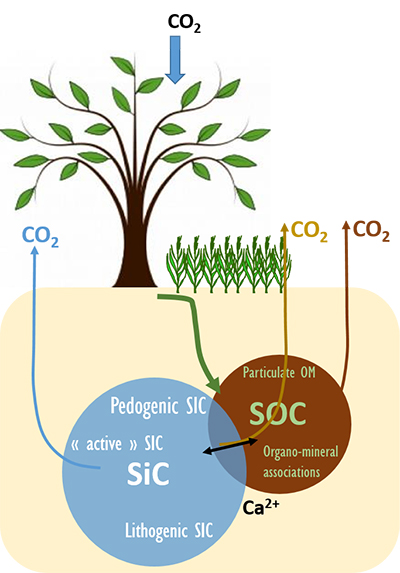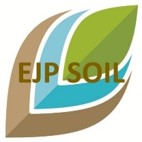 Organic and inorganic carbon dynamics in calcareous soils
Organic and inorganic carbon dynamics in calcareous soils
Objectives
Soil carbon is present as soil organic carbon (SOC) and in calcareous soils, soil carbon is also present as soil inorganic carbon (SIC). These two origin of carbon have different forms, are more or less concentrate and imply different properties of the soils. Scientific community has different knowledge about them. SOC is much more studied than SIC. SOC plays a key role in the physical, chemical and biological properties of soils. SOC can be managed by anthropic activities and it is thought to be much more dynamic than SIC. It is usually thought that SIC is quite inert. And most of all, SOC in soil containing SIC are not so much studied because of methodological issues.
However, SIC is not only fragments of parental material and have different forms in soils. SIC is mainly calcium carbonate (CaCO3) in the form of lithogenic (primary) carbonates inherited from the limestone substratum. SIC could also be in the form of pedogenic (secondary) carbonates precipitated in soil pores or around roots, with different morphologies (nodules, calcite crystals lamellae, or needles) and with variable solubilities. SIC interact with various biological activities. SIC and SOC dynamics are probably not independent of each other. SIC content implies high pH and Ca2+ content, which affect soil structure and biological activity, can modify the mechanisms of SOC stabilization, and the equilibrium between all the forms of SIC in solution. We hypothesis that SIC should impact SOC dynamic and that SIC and SOC interact.
The SIC SOC DYN project is a consortium of 5 teams interested in carbonate soils with a common objective: understand the specificity of SOC dynamics in calcareous soil. The main objective is to document the stabilization of SOC in soils containing SIC and the interactions between SOC and SIC pools.
The project is structured in 3 work packages with 3 specific objectives:
- Establish an harmonized protocol to measure SIC and SOC contents and 13C natural abundance
- Identify stabilized SOC pools in soils with different SIC features
- Quantify a C balance in various carbonated environment.
Aims
Analytical difficulties in measuring SOC and SIC contents separately have often discouraged studies of SOC dynamics in carbonate soils. The C stocks of these soils are therefore poorly characterised and little taken into the accounts of the global C balance. Therefore, SIC-SOC-DYN aims (i) to document the dynamics of SOC in soils containing SIC, and (ii) to understand and formalize the interactions between these two forms of C in soils.
The main activities of the project are (i) to establish protocols on C measurements and especially test the potential of Rock-Eval® analysis to characterize the forms of C in calcareous soils, (ii) to characterize SIC and SOC forms by soil fractionation and (iii) to study the origin of the CO2 emissions from calcareous soils. A large range of contrasted calcareous soil in terms of SIC and SOC contents will be studied.
Date
2022-2024
Funding
EJP Soil - External Call 
Partners
IRD –UMR Eco&Sols, US Imago (Chevallier T., Rakotondrazafy N., Moulin P., Hazera J.)
CSFK – Research Centre for Astronomy and Earth Sciences in Budapest, Hungary (Zachary D., Gergely J., Ringer M., Szalai Z., Filep T.)
IFPEN – Institut Français Pétrole Energies Nouvelles (Kowaleski I., Sebag D., Ravelojaona H., Alvès-Fortunato M., Hazera J.)
University of Milano (Trombino L., Masseroli A.)
AAFC – Agriculture and Agri-Food Canada (Hannam K., Ellert B., Yanni S., Gorzelak M.)

Contact
Tiphaine Chevallier IRD UMR Eco&Sols






